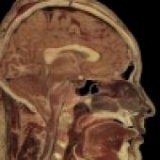Pituitary adenomas: clinical picture, diagnosis, treatment
 Adenoma hypophysis - so in Latin sounds the name of a benign tumor, - adenomas of the pituitary gland. The tumor comes from the cells of the anterior pituitary gland. This is a fairly common ailment. The incidence is one third of all cases of tumor formation inside the skull. The disease often affects people in their youth: from 20 to 40 years. It has the property to combine with neoplasms of other secretory glands. More details about this disease will be discussed in this article "Adenomas of the pituitary: a clinic, diagnosis, treatment."
Adenoma hypophysis - so in Latin sounds the name of a benign tumor, - adenomas of the pituitary gland. The tumor comes from the cells of the anterior pituitary gland. This is a fairly common ailment. The incidence is one third of all cases of tumor formation inside the skull. The disease often affects people in their youth: from 20 to 40 years. It has the property to combine with neoplasms of other secretory glands. More details about this disease will be discussed in this article "Adenomas of the pituitary: a clinic, diagnosis, treatment."
Pituitary adenomas: physiological and anatomical features of
As is known, the pituitary gland is the gland that is among the most important in the endocrine system of the body. This gland consists of anterior lobe or adenohypophysis and posterior lobe or neurohypophysis. They have different functions and origins. The pituitary gland itself is located in the depression at the lower base of the skull. This deepening is also called the "Turkish saddle".In front of the pituitary is the intersection of the nerve fibers responsible for vision, and on the sides to the pituitary gland adjoin the nerve fibers that regulate the movement of the eyeball.
The pituitary body, together with another brain department called the hypothalamus, forms an integral system responsible for controlling all the glands of the human body that are part of the endocrine system. This system was called "hypothalamic-pituitary."The pituitary gland with the hypothalamus is connected by the vascular system, along the vessels the hormones produced by the hypothalamus are transported to the anterior lobe of the pituitary gland. Adenohypophysis, in turn, binds to the peripheral endocrine glands( thyroid, adrenal, ovaries) with the help of a blood stream that flushes the pituitary cells.
Cellular tissue of the anterior lobe of the pituitary gland, possessing a high level of secretory activity, synthesizes hormones that control the functioning of the peripheral glands of the endocrine system. Neoplasms of the pituitary gland, from which most often the adenoma of the pituitary gland arises, is divided into 2 groups: hormonally inactive neoplasms or hormones of non-secreting type and hormonally active tumors or hormones of the secreting type.
Neoplasms that do not have hormone activity manifest themselves by increasing pressure inside the skull and symptoms of squeezing the brain structures. Tumors that have hormonal activity, in addition to these symptoms, also manifest themselves as a violation of the functioning of the glands, which belong to the endocrine system of the peripheral type of the human body.
Pathogenesis and etiology of neoplasms
The pathogenesis and aetiology of pituitary neoplasms have not been sufficiently studied to this day. Scientists suggest that first there is a violation of the functions of the hypothalamus. The pituitary body is involved in this process the second. It often happens that tumors that affect adenohypophysis appear as a consequence of increased stimulation of the pituitary cell tissue by the hormones produced by the hypothalamus. All this occurs against the background of a decrease in the functioning of the glands of the peripheral endocrine system. Do not exclude cases in which tumors develop with primary damage to the pituitary itself, for example, with craniocerebral trauma.
Pituitary tumors: stages of their growth
The anterior pituitary gland( adenohypophysis) is located, as mentioned above, in the "Turkish saddle", and on top it is covered by a fold of the brain envelope. When the tumor is small, it fits perfectly in the "Turkish saddle".When it starts to grow, it grabs adjacent structures and tissues. Below it is a cuneate bone, in front there is a cross of the nerves of vision, and from the sides is a cavernous sinus. Here also there is a neurologic symptomatology.
Pituitary adenomas: Clinic
The clinical picture depends on the type of its functional activity( hormoneally inactive or active), as well as the size of the lesion and the degree of lesion of the structures inside the skull.
If the tumors are small, they develop almost without symptoms, except hormonally active tumors that determine endocrine disruptions. With the growth of the neoplasm, intracranial pressure gradually increases, the nearest brain structures are squeezed, which leads to the onset of headaches, nausea, visual impairment, the disruption of the normal functioning of the nerves responsible for the movement of the eyeballs. Often occurs nasal congestion and the discharge from it of the cerebrospinal discharge.
Tumors of the hormonally active type have the ability to synthesize hormones. With an increase in the level of these hormones, there are certain endocrine syndromes. For example, a tumor that produces the hormone prolactin, causes the development of gynecomastia in men and galactorrhea - amenorrhea in the fairer sex. Neoplasms that produce somatotropin cause the development of acromegaly in an adult and the manifestation of gigantism in children. When the hormone of the corticotropic species is overproduced, a malady, called the Itenko-Cushing syndrome, develops. It often happens that tumors synthesize several types of hormones, as a result of which the clinical picture becomes mixed.
Pituitary adenomas:
diagnostics The radiography of the skull, computed tomography of the cavity of the "Turkish saddle", helps to reveal the tumor. This helps not only to detect the presence of a neoplasm, but also to determine its size, and the degree of damage to adjacent tissues and structures. The type of hormones synthesized by the neoplasm can be determined by biochemical testing and radioimmunoassay. When diagnosing tumors, the clinical picture of the disease, such as the formation of tumors having a non-hypophyseal nature, and the primary endocrine disruption should be completely excluded.
Pituitary adenomas: treatment of
It is difficult to cure tumors of the pituitary gland due to their specific intracranial location. They are small in size, and their manifestations in the endocrine plan are quite complex.
Most often in the treatment of using interstitial and remote radiation therapy, surgery and medication. For each patient, treatment is selected individually. The best results are achieved with complex treatment. Those who have undergone a treatment complex to eliminate this problem must constantly be under the control of the endocrinologist, because the development of hypothalamic-pituitary insufficiency is possible. If this happens, the patient is prescribed hormone replacement therapy, which is administered for life.
Pituitary adenomas: predictions
Predicting the development of the disease is difficult, it all depends on the size of the neoplasm, type, treatment. Favorable predictions are in cases of prolactinoma.



